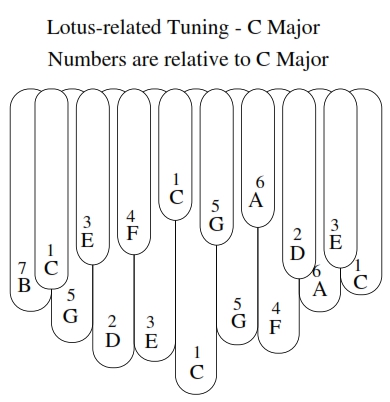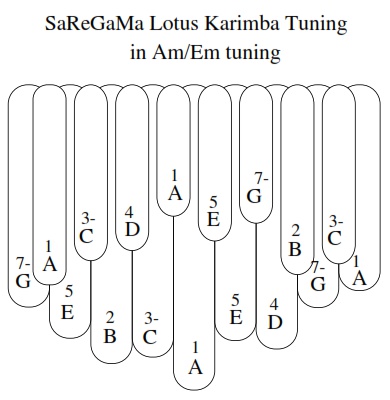Yesterday, two sansula players came to Kalimba Magic headquarters with their sansulas, both of which were in standard A minor tuning. They had grown tired of the enchantingly beautiful standard A minor tuning and wanted to play different music. After trying several tunings, they both decided to go for the Heavenly A tuning. They left happy, and the new tuning has opened many new pathways for them to explore.
Why am I telling you this in an article about Lotus Karimba tunings? Because the standard Lotus tuning (which is equally good for playing in G minor or C minor) itself can become boring if you are trapped in the same old patterns, and a new Lotus tuning may be exactly what you need to break out of the doldrums.
Here is something to consider about kalimba tunings: A kalimba’s tuning goes hand in hand with the music it plays. The tuning should make it easy to play beautiful music.
A kalimba tuning is something like a double-edged sword: on one edge, we promise that the kalimba’s tuning will sound great – we have removed all of the “wrong notes,” and the exact layout of this particular tuning suggests some notes be used together and inhibits other notes from being played together. On the other edge, every step we take to simplify the tuning gives it more limits, which results in an instrument that is generally less capable – less capable of playing notes that sound like mistakes, but also somewhat less capable of doing something great or amazing. Certainly less capable of doing something unexpected.
Once we have become familiar with the ways of a particular tuning, we might feel that the magic is gone. We sort of know what the instrument is going to do. Don’t get me wrong, this is fundamental to becoming a great kalimba player. You need to know and understand every note on the instrument. You need to be able to imagine a sound in your head, and immediately know if that note is on your kalimba, and if so, exactly where it is. On the other hand, part of the joy of the kalimba is to twiddle your thumbs without knowing what is going to happen, without being in control – and WHAM! magic happens anyway! I think this is a very good reason for seeking out a new tuning on an instrument that you have had for a while, but aren’t feeling that special spark from anymore. You don’t need to get a new kalimba, you just need to make the kalimba you have in your hands feel and sound different.

Now, the Lotus Karimba itself is a new tuning – SaReGaMa invented it from the Hugh Tracey African-tuned karimba. The Lotus tuning actually requires taking the original instrument apart and rearranging it to optimally match the long tines with low notes, and as such, we cannot recommend that you do this at home. The new C Major Lotus tuning, on the other hand, requires only a slight adjustment from the standard Lotus tuning, and it IS an operation that you can do, in the privacy of your own home, with the help of an electronic tuner and a Pilot G-2 pen (retract the ball point of the pen, and the plastic at the end of the pen forms a perfect shape to grasp a karimba tine end to push it in or out). It should take you 5-20 minutes to accomplish this retuning, and the process is 100% reversible to the standard tuning if you decide you don’t like the C major tuning.
What does the C major tuning get you that you don’t have in the standard Lotus tuning?
I think that about 90% of kalimba players who are over the age of 18 should be able to accomplish a simple retuning on their own. I know that a good share of those capable people will also have moderate difficulty – pushing a tine too far in, then pulling it out too far, and getting frustrated. This frustration is something you can work through, I promise. And the more often you tune your kalimba, the better you will become at it.
If you feel you don’t have the skills or patience to retune your kalimba or karimba, or if you attempted to retune and now are stuck and don’t know what to do next, the following may be of help: Retuning Services through the Kalimba Doctor. Learn More About Tuning the Kalimba Yourself
While we are introducing new Lotus tunings, we should also mention the new Am/Em (A minor/E minor) Lotus tuning. It is just like the standard Cm/Gm Lotus tuning, except everything has been shifted down by a minor third. You can play the exact same music as on it as you can on the Lotus karimba, and the difference is not very obvious, but everything will be pitched somewhat lower. The main reason to get the Am/Em tuning instead of the standard Cm/Gm tuning is to facilitate playing with other kalimbas. In the Cm/Gm tuning, the Lotus can play with the Bb Treble kalimba (Bb and Gm are close relatives and share the same notes), or with other instruments that have been tuned to G minor or C minor. In the Am/Em tuning, we can play with any kalimba that is in C major or G major – meaning almost every Catania kalimba or Hugh Tracey kalimba that is in standard tuning. In other words, you can get that cool SaReGaMa Lotus feel while you are making music with your friends as they play your other kalimbas!



Sign up for our newsletter and free resources with your email address:
We pinky promise not to spam you and to only send good stuff.
 Christmas in July 2025
Christmas in July 2025 Patriotic and American Music for Kalimba
Patriotic and American Music for Kalimba